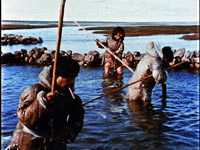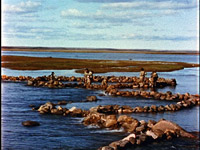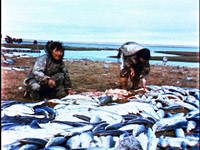


Fishing at the Stone Weir
[Research does not support the folk etymology of "Eskimo" as "eaters of raw meat"]
Netsilik At the winter sea-ice camp
"Presents the traditional way of life of the Netsilik Eskimos of the Pelly Bay Region in the Canadian Arctic as it was lived before European acculturation."
(xxx min., 1994/1967, VC 2567)
At the Winter Sea Ice Camp
Part 1, color, 36 minutes - click here to preview this film
In late winter when the cold is severe, the people and dogs are glad to stop their trek and make camp. In the blue dusk the men probe the snow and then cut building blocks while the women shovel a site. Soon all are under cover, and in the wavering light of the stone lamp they sleep, their breath rising coldly. In the light of day the men test and refurbish their spears, harness dogs to the sled and strike out on the sea ice. Each man, with a dog or two, explores the white waste, seeking scent of a seal's breathing hole. When a dog noses the snow, the man probes for the hole and, when he finds it, suspends a single looped hair to signal when the seal rises to breathe. Then he waits, motionless, to make his strike. He kills, and the others gather to taste the warm liver of his catch. Then, as night comes, the vigil goes on.
Part 2, color, 36 minutes - click here to preview this film
In the morning the women spread the furs over the igloos to air. The children play, striking a ball of fur with a bone bat. The men wait patiently for sign of seals and the women play with the babies, sew, repair the igloos, nurse a child; an old woman rocks as she chants. A woman shows an older girl how to shape and cut fur for clothing. Then the seals begin to arrive, towed by the hunters. The women dress the seals, eating between times, passing the knife along as needed. The men come in with their catch, and soon all are indoors.
or
At the Caribou Crossing Place
Part 1, color, 30 minutes - click here to preview this film
The time is early autumn. The woman wakes and dresses the boy. He practices with his sling while she spreads a caribou skin to dry. The boy picks berries and then the men come in their kayak with another caribou. This is skinned, and soon night falls. In the morning, one man leaves with his bow while the other makes a fishing mannick, a bait of caribou meat. The woman works at the skins, this time cleaning sinews and hanging them to dry. The man repairs his arrows and then sets a snare for a gull. The child stones the snared gull and then plays hunter, using some antlers for a target. His father makes him a spinning top.
Part 2, color, 29 minutes - click here to preview this film
Two men arrive at the camp and the four build from stones a long row of manlike figures, inukshult, down toward the water. They wait for caribou and then chase them toward the stone figures and so into the water where other men in kayaks spear them. The dead animals are floated ashore and skinned. The boy plays with the visitors, the woman cooks the meat, the men crack the bones and eat the marrow, and then feast on the plentiful meat.

